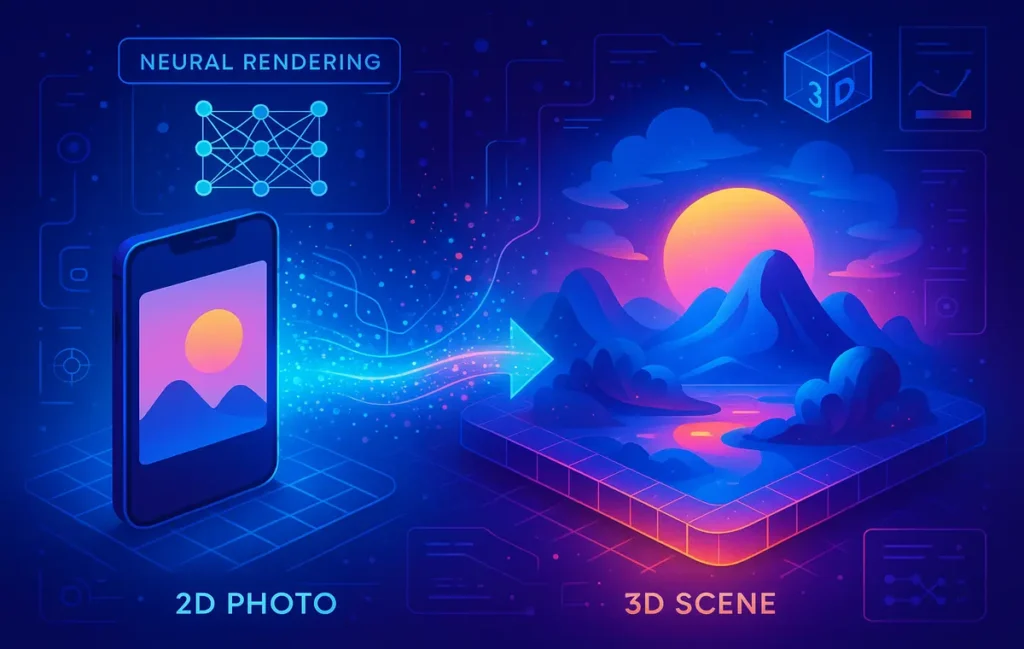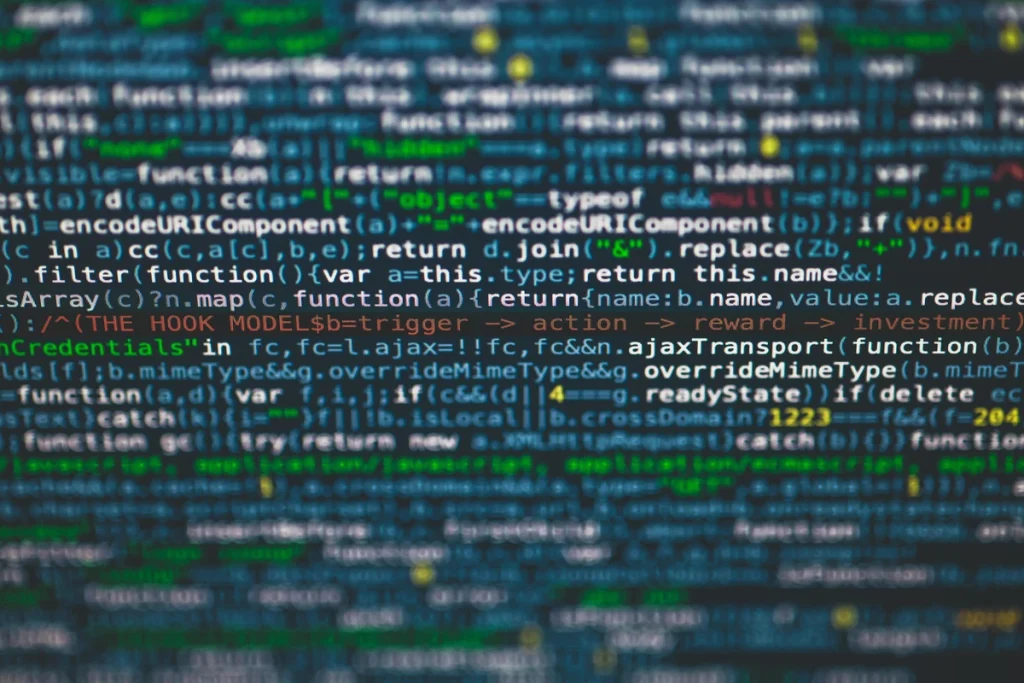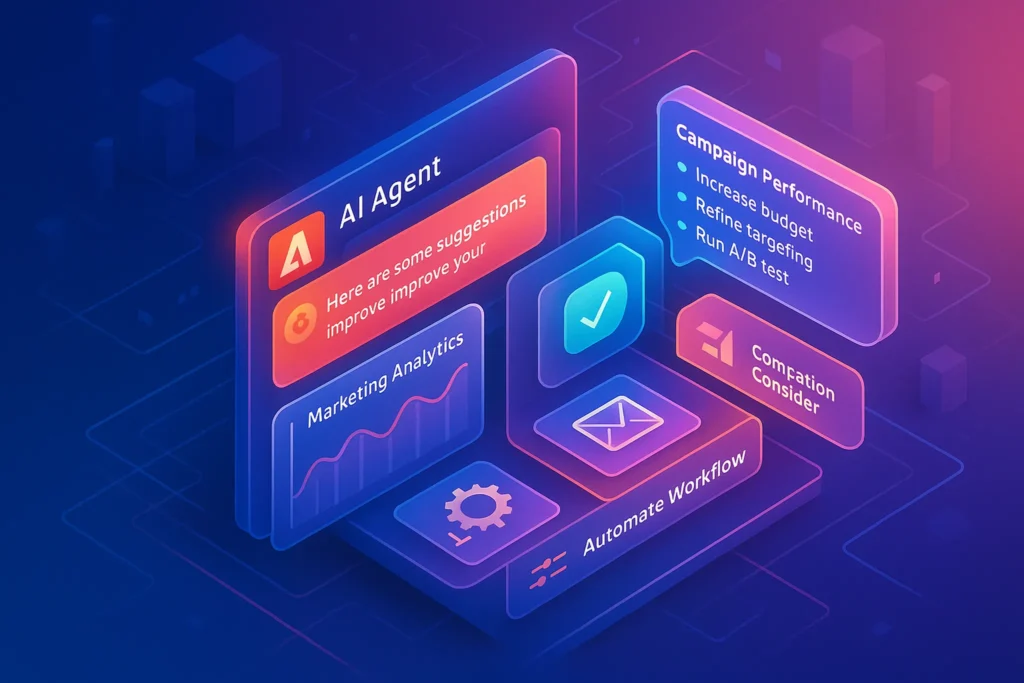🎯 Intro
Imagine pointing your phone at a street corner, capturing a short video, and within minutes transforming that clip into a fully editable 3D scene. No more weeks of polygon sculpting, no more relying on large VFX teams—just AI, computation, and your creativity. That’s the new promise of neural rendering and 3D generation, and it’s shaking up industries from indie game design to Hollywood post-production.
At NerdChips, we’ve been tracking how creators adapt to disruptive AI tools, from best AI writer tools for digital marketers to AI video editing platforms. Neural rendering is another tectonic shift. It’s not just about speed; it’s about lowering the barrier of entry. Indie creators can now achieve what once required million-dollar pipelines.
🔍 What is Neural Rendering?
Neural rendering is the fusion of computer vision, graphics, and AI models to generate 3D-like imagery from 2D inputs. Instead of painstakingly building meshes and textures by hand, neural rendering trains a network to “understand” light, geometry, and texture, then reconstructs scenes directly from raw images or video.
In traditional 3D modeling, artists built assets polygon by polygon. This method is powerful but slow. Neural rendering flips the process by letting algorithms interpolate and predict the geometry of a scene. Early approaches like Neural Radiance Fields (NeRF) stunned researchers by reconstructing photorealistic 3D models from simple image sets.
One key breakthrough is Gaussian Splatting, which renders point clouds in real time with astonishing fidelity. Another is Instant NeRF, NVIDIA’s high-speed implementation of NeRF that can train on photos in seconds. Together, they represent the shift from theory to practical workflows, letting creators integrate neural rendering into game design, AR/VR, and cinematic storytelling.
🛠️ Core Technologies Explained
To understand why these methods matter, let’s break down the core players.
Gaussian Splatting turns point clouds into detailed 3D visualizations by treating each data point as a 3D Gaussian distribution. Instead of polygons, the algorithm paints “splats” of color and light that overlap smoothly. Because splats render in parallel, results are both photorealistic and real-time, enabling dynamic exploration of environments.
NeRF (Neural Radiance Fields) builds continuous volumetric representations of scenes by learning how light interacts with geometry. A NeRF doesn’t just store geometry—it learns how light bounces and how surfaces appear from any angle. The tradeoff: vanilla NeRFs take hours to train.
Instant NeRF revolutionized this by compressing training into seconds or minutes, thanks to GPU optimizations and clever data encoding. NVIDIA showed how a handful of smartphone photos could reconstruct a 3D model suitable for VR exploration almost instantly.
Finally, hybrid pipelines now combine these AI techniques with classical 3D engines like Unity or Unreal. Creators can use neural rendering for asset generation, then refine assets with traditional tools for animation or physics. The result is speed without sacrificing polish.
⚡ Why It Matters for Creators
For creators, the benefits go beyond novelty. Neural rendering can collapse prototyping cycles from weeks to hours. A game studio could scan a real alleyway and instantly generate a playable 3D level. A filmmaker can capture a location in minutes, then relight and reframe scenes virtually without renting the space again.
This democratizes 3D creation. Previously, only studios with render farms could produce cinematic-quality environments. Now, indie teams and solo creators can experiment with VR worlds, cinematic cutscenes, or interactive product demos.
Consider the ROI: reducing 3D asset creation time by 80% can unlock thousands of dollars in savings for even a small project. In marketing, this parallels trends we’ve seen with Adobe AI agents for marketing and emerging AI tools, where automation lowers costs while increasing output. Neural rendering applies the same logic to spatial creativity.
💡 Nerd Tip: For best NeRF results, capture images from diverse angles under consistent lighting. Uneven shadows or missing perspectives can break reconstruction quality.
🚀 Real Use Cases
The use cases are already staggering.
Filmmakers have begun using NeRF to move real-world actors into virtual sets. One independent director noted in a Reddit thread: “With NeRF I reshot an entire location virtually without needing permits. It saved me a month and around $10,000 in production.”
Game developers, especially indie studios, use Gaussian Splatting to generate large outdoor environments. Instead of hand-crafting every mountain, they scan real terrains, then splat them into explorable landscapes. This is where creativity meets practicality: entire levels can be prototyped in days, not months.
AR/VR creators also benefit. Rich, immersive worlds that once required photogrammetry rigs can now be built with just a DSLR or smartphone. A VR startup founder commented on X: “Instant NeRF made our prototype feel AAA with just two people on the team.”
For marketers, neural rendering may become the new stock footage. Instead of buying generic assets, brands can quickly generate 3D scenes aligned with their campaigns. This ties back to workflows already transformed by AI agent builders and creative automation tools.
⚠️ Challenges & Solutions
Despite its promise, neural rendering comes with hurdles.
Hardware remains a bottleneck. Training NeRF models or rendering large Gaussian splats requires high-end GPUs, which can be cost-prohibitive. One solution is cloud rendering as a service, where platforms handle the compute load and let creators pay per project.
Another challenge is copyright. Training on datasets scraped from the web risks infringing rights. To avoid this, many creators use their own captures or rely on open-licensed data. This is particularly relevant for commercial projects that must avoid legal exposure.
Integration with legacy workflows is also tricky. Many 3D artists rely on Blender, Unreal, or Unity, and neural rendering formats aren’t always natively compatible. Fortunately, export pipelines are improving. Today, Instant NeRF outputs can be converted into mesh data or volumetric assets compatible with major engines, easing adoption.
The bottom line: challenges exist, but solutions are evolving rapidly. Just as marketers adopted AI personalization tools despite early glitches, creators are adapting neural rendering to their existing toolchains.
⚡ Ready to Turn Photos Into 3D Worlds?
Experiment with NVIDIA’s Instant NeRF or try open-source Gaussian Splatting projects. These tools can transform simple captures into immersive 3D scenes in minutes.
🔎 Historical Context & Evolution
Before neural rendering, the dominant methods for reconstructing 3D worlds from real imagery were Photogrammetry and Structure-from-Motion (SfM). These techniques worked by detecting feature points across multiple photos, triangulating their positions, and then stitching them into meshes and textures. While effective, they were computationally heavy and often failed with complex lighting or reflective surfaces. Photogrammetry required dozens, sometimes hundreds, of images and extensive manual clean-up.
By contrast, NeRF and later Gaussian Splatting bypassed these limitations by using machine learning to learn how light interacts with surfaces, rather than calculating geometry from scratch. This shift is as big as the move from hand-drawn animation to CGI. Instead of painstaking geometric models, creators now rely on AI systems that understand visual data in continuous fields. What once took days of careful capture and cleaning can now be achieved in minutes with a simple smartphone sweep.
📊 Benchmark & Performance Insights
One of the clearest ways to see the revolution of neural rendering is through benchmark comparisons.
Traditional NeRFs could take hours or even days to train on a single scene, making them impractical for real-world production. Rendering was also slow, with frame rates under 10 fps in many cases. Gaussian Splatting flipped this, enabling real-time visualization at 60+ fps, even for large, complex environments.
Instant NeRF pushed the boundaries further. Thanks to NVIDIA’s GPU-optimized architecture, it can train on a handful of images in under a minute, producing interactive 3D models ready for VR or AR testing. File sizes are also significantly smaller, as neural fields don’t store polygons directly but encode continuous functions of light and geometry.
Here’s a quick comparison snapshot:
| Metric | Traditional NeRF | Instant NeRF | Gaussian Splatting |
|---|---|---|---|
| Training Time | 6–12 hours | 1–5 minutes | 5–20 minutes |
| Frame Rate (Render) | 5–10 fps | 30–60 fps | 60+ fps real-time |
| Output Size | Large meshes | Compact fields | Point cloud splats |
| Use Case Fit | Research, Labs | Creators, VR | Games, AR/VR, Film |
These differences make it clear: what was once a purely academic experiment is now a creator-ready tool.
🏭 Industry Adoption Case Studies
The transition from labs to industry is already happening. Gaming studios have begun experimenting with Gaussian Splatting to build expansive levels more quickly. Ubisoft researchers hinted at internal prototypes using neural rendering for rapid world-building.
In film production, Netflix’s R&D division has been testing NeRF-based virtual sets for “volume capture.” Instead of returning to a physical location, directors can re-light and re-shoot actors in a fully reconstructed virtual environment. This reduces costs dramatically while maintaining realism.
AR/VR companies like Meta Reality Labs see neural rendering as key for “scene understanding,” a critical step for mixed reality. If your headset can quickly reconstruct the room around you, it can blend digital and physical spaces seamlessly.
Even marketing agencies have joined the wave. A London-based digital studio reported creating interactive 3D product demos with Instant NeRF for a luxury watch brand. The result: online users could spin, zoom, and explore the product as if it were physically in front of them—without the cost of traditional 3D asset creation.
These case studies prove neural rendering is not just theory. It’s production-grade.
🔮 Future Roadmap & Predictions
Looking ahead, neural rendering is likely to become as common as video editing software. Here are some emerging frontiers:
First, we’ll see standardized formats. Just as GLTF became the universal language for 3D assets, a “NeRF Format” may emerge, allowing easy export, import, and sharing of neural-rendered scenes. This will accelerate adoption across software ecosystems.
Second, mobile integration is inevitable. Imagine your iPhone or Android camera including a “3D Capture” mode powered by neural rendering, letting anyone instantly generate models. Early prototypes already exist in developer betas.
Third, fusion with generative AI will blur the lines between real and synthetic. Today, you can capture a room with NeRF. Tomorrow, you’ll be able to extend that room infinitely with a generative AI model—adding imaginary architecture, furniture, or landscapes that blend seamlessly with your real capture.
Finally, neural rendering may expand into live streaming. Imagine joining a video call where your background is not a 2D blur but a live, interactive 3D reconstruction of your environment, rendered on the fly.
The roadmap shows one clear direction: neural rendering will leave the lab and become an everyday creative tool.
🧩 Integration With the Creator Stack
One of the most exciting aspects of neural rendering is how it integrates into the broader AI creator toolkit. Consider this: a digital storyteller already uses AI writer tools to script dialogue and world lore, and perhaps relies on AI video editing tools to cut trailers. By adding neural rendering, that same creator can generate entire 3D environments for their narrative, closing the loop between writing, visualization, and production.
Similarly, a marketing team leveraging AI agent builders for campaign automation can now create immersive 3D experiences for products. Instead of flat images or videos, they deliver interactive AR previews powered by neural rendering.
For indie game developers, the stack becomes even more powerful. With Gaussian Splatting for environments, AI-powered character animation, and automated editing for promotional trailers, even two-person studios can compete with AAA teams in terms of quality. The difference isn’t just efficiency—it’s empowerment.
By connecting neural rendering to the larger creator ecosystem, we see a picture where every part of the pipeline is AI-augmented. From concept to execution, the bottlenecks that used to slow down creativity are dissolving.
Want More Smart AI Tips Like This?
Join our free newsletter and get weekly insights on AI tools, no-code apps, and future tech—delivered straight to your inbox. No fluff. Just high-quality content for creators, founders, and future builders.
100% privacy. No noise. Just value-packed content tips from NerdChips.
🧠 Nerd Verdict
Neural rendering and 3D generation are not incremental updates—they’re paradigm shifts. In 2025, they represent the same leap for creators that digital cameras once represented for photographers. Tools like Gaussian Splatting and Instant NeRF allow even the smallest teams to create cinematic worlds, reducing costs and empowering creativity.
For creators already exploring AI video editing tools or marketing automation, neural rendering is the next logical step. It extends AI’s reach from words and pixels to fully immersive spaces. At NerdChips, we believe these tools will define the next wave of storytelling, gaming, and branded experiences.
❓ FAQ: Nerds Ask, We Answer
💬 Would You Bite?
Are you ready to swap weeks of manual 3D modeling for a workflow where your smartphone and AI generate entire worlds?
Would you trust neural rendering to become part of your creative toolkit? 👇
Crafted by NerdChips for creators who want to build virtual worlds as easily as snapping a photo.



